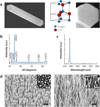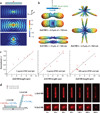Fundamental Properties of One-Dimensional Zinc Oxide Nanomaterials and Implementations in Various Detection Modes of Enhanced Biosensing
- PMID: 27215822
- PMCID: PMC4894344
- DOI: 10.1146/annurev-physchem-031215-010949
Fundamental Properties of One-Dimensional Zinc Oxide Nanomaterials and Implementations in Various Detection Modes of Enhanced Biosensing
Abstract
Recent bioapplications of one-dimensional (1D) zinc oxide (ZnO) nanomaterials, despite the short development period, have shown promising signs as new sensors and assay platforms offering exquisite biomolecular sensitivity and selectivity. The incorporation of 1D ZnO nanomaterials has proven beneficial to various modes of biodetection owing to their inherent properties. The more widely explored electrochemical and electrical approaches tend to capitalize on the reduced physical dimensionality, yielding a high surface-to-volume ratio, as well as on the electrical properties of ZnO. The newer development of the use of 1D ZnO nanomaterials in fluorescence-based biodetection exploits the innate optical property of their high anisotropy. This review considers stimulating research advances made to identify and understand fundamental properties of 1D ZnO nanomaterials, and examines various biosensing modes utilizing them, while focusing on the unique optical properties of individual and ensembles of 1D ZnO nanomaterials specifically pertaining to their bio-optical applications in simple and complex fluorescence assays.
Keywords: biomedical detection; biosensing; enhanced fluorescence detection; nanorod optical property; optical signal enhancement; zinc oxide nanomaterial.
Figures










References
-
- Wang ZL. Splendid one-dimensional nanostructures of zinc oxide: a new nanomaterial family for nanotechnology. ACS Nano. 2008;2:1987–1992. - PubMed
-
- Gao PX, Wang ZL. Substrate atomic-termination-induced anisotropic growth of ZnO nanowires/nanorods by the VLS process. J. Phys. Chem. B. 2004;108:7534–7537.
-
- Kumar N, Dorfman A, Hahm JI. Fabrication of optically enhanced ZnO nanorods and microrods using novel biocatalysts. J. Nanosci. Nanotechnol. 2005;5:1915–1918. - PubMed
-
- Park WI, Kim DH, Jung SW, Yi GC. Metalorganic vapor-phase epitaxial growth of vertically well-aligned ZnO nanorods. Appl. Phys. Lett. 2002;80:4232–4234.
Publication types
MeSH terms
Substances
Grants and funding
LinkOut - more resources
Full Text Sources
Other Literature Sources

